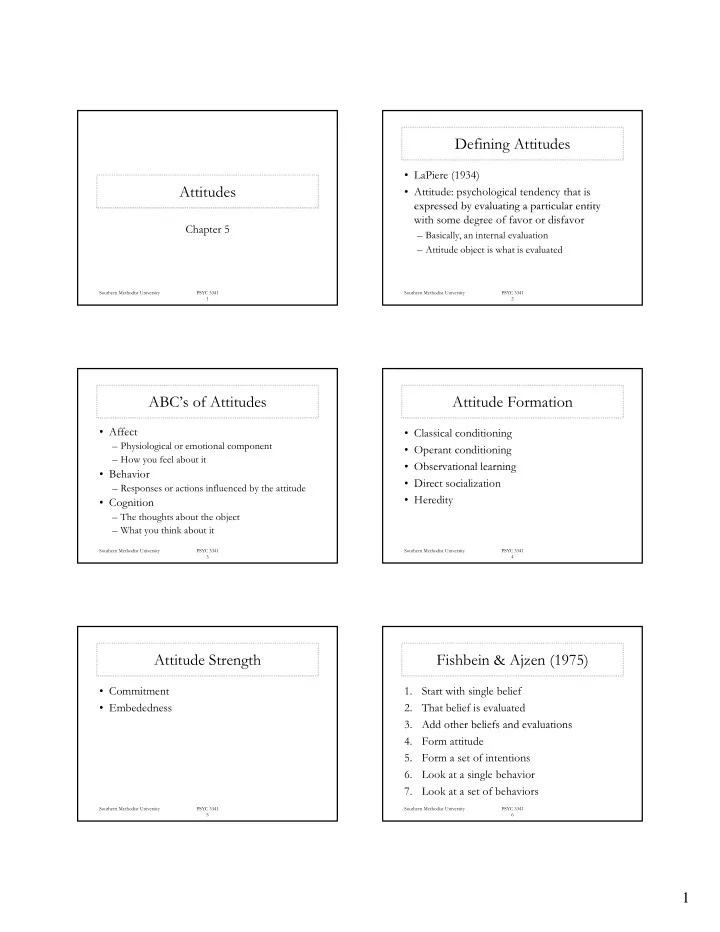

Defining Attitudes • LaPiere (1934) Attitudes • Attitude: psychological tendency that is expressed by evaluating a particular entity expressed by evaluating a particular entity with some degree of favor or disfavor Chapter 5 – Basically, an internal evaluation – Attitude object is what is evaluated Southern Methodist University PSYC 3341 Southern Methodist University PSYC 3341 1 2 ABC’s of Attitudes Attitude Formation • Affect • Classical conditioning – Physiological or emotional component • Operant conditioning – How you feel about it • Observational learning • Observational learning • Behavior • Direct socialization – Responses or actions influenced by the attitude • Heredity • Cognition – The thoughts about the object – What you think about it Southern Methodist University PSYC 3341 Southern Methodist University PSYC 3341 3 4 Attitude Strength Fishbein & Ajzen (1975) • Commitment 1. Start with single belief • Embededness 2. That belief is evaluated 3 3. Add other beliefs and evaluations Add other beliefs and evaluations 4. Form attitude 5. Form a set of intentions 6. Look at a single behavior 7. Look at a set of behaviors Southern Methodist University PSYC 3341 Southern Methodist University PSYC 3341 5 6 1
Fishbein & Ajzen • Principle of correspondence 1. An attitude should be consistent with a set of beliefs, not necessarily any single belief. 2 2. An attitude should be consistent with a set of intentions An attitude should be consistent with a set of intentions, not necessarily any single intention. 3. People generally do what they intend to do. 4. An attitude should be consistent with a set of behaviors, not necessarily any single behavior. • Attitudes predict behavior at corresponding levels of specificity Southern Methodist University PSYC 3341 Southern Methodist University PSYC 3341 7 8 Measuring Attitudes Measuring Attitudes • Jones & Sigall (1971) – Bogus Pipeline • Physiological measures Physiological measures – GSR (Galvanic skin response) – Pupillary response – Self report of affect – Facial electromyographic activity Southern Methodist University PSYC 3341 Southern Methodist University PSYC 3341 9 10 Connecting Attitudes and Measuring Attitudes Behavior • Standard self-report measures • Salience – Bogardus’ Social Distance scale – Priming – Error-choice method Error choice method • Strengthen attitudes Strengthen attitudes – Semantic differential • Form intentions – Likert-type scale • Create a plan to carry out action Southern Methodist University PSYC 3341 Southern Methodist University PSYC 3341 11 12 2
Inferring attitudes from behavior Inferring attitudes from behavior • Cognitive consistency (cont’d) • Role playing – Cognitive dissonance – Zimbardo’s prison experiment • Inconsistency causes arousal • Cognitive consistency theories Cognitive consistency theories • There is a drive to reduce that arousal – Balance theory • Attitudes change to reduce arousal – Selective Perception – Impression management • Selective exposure • Self monitoring • Selective attention • Selective interpretation Southern Methodist University PSYC 3341 Southern Methodist University PSYC 3341 13 14 Inferring attitudes from behavior • Bem’s Self-perception theory – We infer our attitudes from our behavior – Motivation Motivation • Intrinsic • Extrinsic – Affect-as-information concept Southern Methodist University PSYC 3341 Southern Methodist University PSYC 3341 15 16 History • Early contradictions Persuasion (Attitude Change) • Possible explanation • Distraction effect • Distraction effect • Cognitive elaboration theories – “self-talk” – Petty & Cacioppo’s ELM • Elaboration Likelihood Model Southern Methodist University PSYC 3341 Southern Methodist University PSYC 3341 17 18 3
ELM Source Factors • Description of the model • Credibility • Other factors that affect persuasion within – Sleeper effect the model the model – Perceived trustworthiness Perceived trustworthiness – Perceived Expertise – Source Factors • Attractiveness – Message Factors – Channel Factors – Halo effect – Recipient Factors Southern Methodist University PSYC 3341 Southern Methodist University PSYC 3341 19 20 Message Factors Channel Factors • One sided vs. two sided • Face to face • Reason vs. Emotion • Video • Fear • Fear • Text • Text Southern Methodist University PSYC 3341 Southern Methodist University PSYC 3341 21 22 Recipient Factors Cult Indoctrination • Mood • Characterized by: – Rituals of devotion • Age – Isolation from surrounding “evil” culture – Charismatic leader • Indoctrination – Attitudes follow behavior – Persuasive elements – Group effects • Social implosion Southern Methodist University PSYC 3341 Southern Methodist University PSYC 3341 23 24 4
Resisting Persuasion • Attitude inoculation – Strengthen personal commitment – Mildly challenge beliefs Mildly challenge beliefs • Leads to counterarguments Southern Methodist University PSYC 3341 25 5
Recommend
More recommend